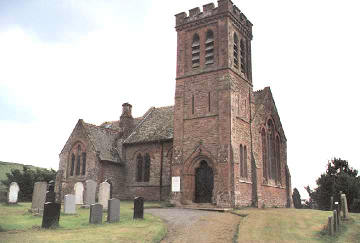 Cumrew village is distant about seven miles S. of
Brampton, and twelve E.S.E. of Carlisle. The Church, dedicated to St. Mary, is a
small but neat edifice, with a tower at the west end carrying two bells. The living is a
curacy, in the patronage of the dean and chapter of Carlisle, and incumbency of the Rev.
John Watson, "who has a lease pro tempore, of all the church right, under the
yearly rent of ten eskeps1 of haver2
meal and one pound sterling in money, clear of outgoings." It was certified to the
ecclesiastical commissioners as of the average annual value of £81, but is now worth
£100 a year, arising from land and tithes under the lease from the dean and chapter, and
land in the parishes of Ainstable and Cumwhitton, purchased by three several grants from
the governors of queen Anne's bounty. The clergyman's residence is a commodious dwelling,
erected in 1832, at a cost of about £400, towards which the Rev. J. Watson gave £200,
and the governors of queen Anne's bounty the like sum. A school and house for the master
were erected here in 1847, on a piece of ground belonging to the parish, at a cost of
£190, of which the committee of council contributed £57; the Rev. J. Watson, £55; lord
Morpeth, £10; the dean and chapter, £3; and the landowners the remainder. The minister
and churchwardens for the time being are trustees. It has no endowment, the master's
salary being made up by a small annual subscription, and payments from the scholars.
Cumrew village is distant about seven miles S. of
Brampton, and twelve E.S.E. of Carlisle. The Church, dedicated to St. Mary, is a
small but neat edifice, with a tower at the west end carrying two bells. The living is a
curacy, in the patronage of the dean and chapter of Carlisle, and incumbency of the Rev.
John Watson, "who has a lease pro tempore, of all the church right, under the
yearly rent of ten eskeps1 of haver2
meal and one pound sterling in money, clear of outgoings." It was certified to the
ecclesiastical commissioners as of the average annual value of £81, but is now worth
£100 a year, arising from land and tithes under the lease from the dean and chapter, and
land in the parishes of Ainstable and Cumwhitton, purchased by three several grants from
the governors of queen Anne's bounty. The clergyman's residence is a commodious dwelling,
erected in 1832, at a cost of about £400, towards which the Rev. J. Watson gave £200,
and the governors of queen Anne's bounty the like sum. A school and house for the master
were erected here in 1847, on a piece of ground belonging to the parish, at a cost of
£190, of which the committee of council contributed £57; the Rev. J. Watson, £55; lord
Morpeth, £10; the dean and chapter, £3; and the landowners the remainder. The minister
and churchwardens for the time being are trustees. It has no endowment, the master's
salary being made up by a small annual subscription, and payments from the scholars.
In Dugdale's baronage it is mentioned that a castle called Dumwalloght was situate on the borders; and Hutchinson says that in a field here, near the church, "lie the ruins of a large edifice, but so confused and destroyed as not to shew its original form, or any marks to discover its strength or the era when it was erected." These two small hillocks were removed in 1832, when one of them was found to have been composed entirely of small stones gathered from the land, and the other of rubbish; but in neither was there any appearance of foundations or buildings, so that the conjecture respecting this being the site of the castle alluded to by Dugdale must be erroneous. The Dacres did formerly possess two small estates here, which were sold to Sir Christopher Musgrave. On the summit of the neighbouring mountain is a cairn of stones, where was found a human skeleton; and in a small cairn on the estate belonging to John Gill, Esq., an urn has been found.
Abbey Field and Brackenthwaite are two small hamlets in this parish; the former 1, and the latter 1½ mile N. of Cumrew.
Mannix & Whellan, History, Gazetteer and Directory of Cumberland, 1847